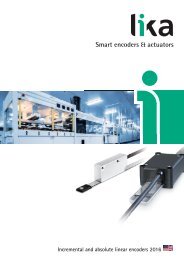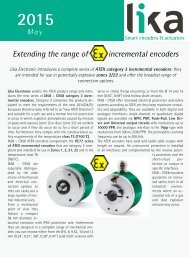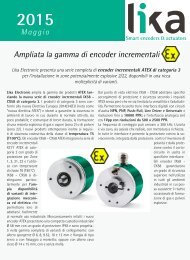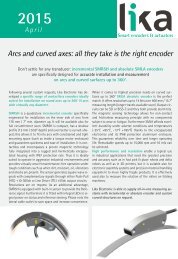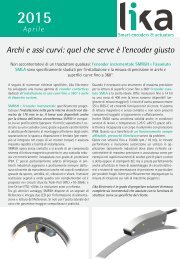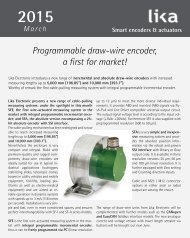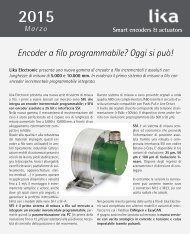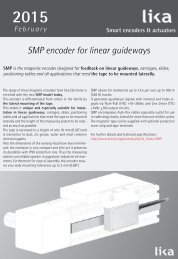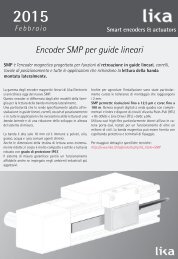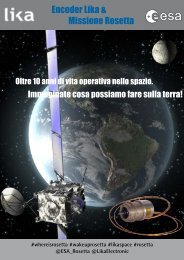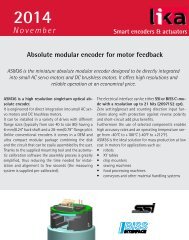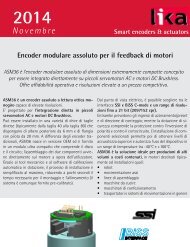Rosetta space mission: a 10-year long story (and it's not all over) EN
Have you heard about Rosetta mission? After a 10-year journey that has clocked up more than 6 billion kilometres, the European Space Agency’s Rosetta spacecraft has deployed the Philae lander to the surface of Comet 67P/Churyumov–Gerasimenko on Wednesday November 12th. Lika Electronic is proud to be part of the international team of companies, institutes and universities that, under the guide of the European Space Agency, has allowed to achieve this historic result. Over 10 years ago our technology, innovation and even passion led us to build for Rosetta mission the I38 Space encoder, the first space encoder designed and manufactured in Italy; nowadays they guide us in our each day-to-day commitment in close cooperation with our customers and partners. Download the brochure and learn more about the mission and our I38 space encoder mounted on the shutter mechanism of WAC and NAC cameras of OSIRIS.
Have you heard about Rosetta mission? After a 10-year journey that has clocked up more than 6 billion kilometres, the European Space Agency’s Rosetta spacecraft has deployed the Philae lander to the surface of Comet 67P/Churyumov–Gerasimenko on Wednesday November 12th. Lika Electronic is proud to be part of the international team of companies, institutes and universities that, under the guide of the European Space Agency, has allowed to achieve this historic result. Over 10 years ago our technology, innovation and even passion led us to build for Rosetta mission the I38 Space encoder, the first space encoder designed and manufactured in Italy; nowadays they guide us in our each day-to-day commitment in close cooperation with our customers and partners. Download the brochure and learn more about the mission and our I38 space encoder mounted on the shutter mechanism of WAC and NAC cameras of OSIRIS.
Create successful ePaper yourself
Turn your PDF publications into a flip-book with our unique Google optimized e-Paper software.
Lika encoders &<br />
the <strong>Rosetta</strong> Mission<br />
Over <strong>10</strong> <strong>year</strong>s of operational lifetime in the <strong>space</strong>.<br />
Guess what we can do on earth!<br />
#whereisrosetta #wakeuprosetta #lika<strong>space</strong> #rosetta<br />
@ESA_<strong>Rosetta</strong> @LikaElectronic
Lika Electronic, heading for <strong>space</strong><br />
ROSETTA pioneering <strong>space</strong>craft: a <strong>10</strong>-<strong>year</strong> <strong>long</strong> <strong>story</strong> (<strong>and</strong> it’s <strong>not</strong> <strong>all</strong> <strong>over</strong>!)<br />
<strong>Rosetta</strong> is the ESA’s (European Space Agency) scientific project involving a consortium<br />
of more than 50 contractors (private companies, institutes <strong>and</strong> universities)<br />
in Europe <strong>and</strong> the United States. It is the first <strong>mission</strong> planned to orbit<br />
<strong>and</strong> l<strong>and</strong> on a Comet.<br />
<strong>Rosetta</strong> probe (fig. 1) was launched by Ariane 5 <strong>space</strong>craft on 2nd March, 2004,<br />
from Europe’s Spaceport in Kourou, French Guiana on an <strong>10</strong>-<strong>year</strong> journey to<br />
the Comet 67P/Churyumov-Gerasimenko. It is designed to enter orbit around<br />
the Comet’s nucleus in August 2014 after a series of gravity assist manoeuvres<br />
to gain enough orbital energy, with three swing-bys at Earth (March 2005, November<br />
2007 <strong>and</strong> November 2009; see fig. 2) <strong>and</strong> one at Mars (February 2007).<br />
En route to the Comet, the star r<strong>over</strong> will flyby the asteroids Steins (September<br />
2008) <strong>and</strong> 21 Lutetia (July 20<strong>10</strong>). <strong>Rosetta</strong> <strong>space</strong>craft carries eleven science<br />
instruments to probe the Comet’s nucleus <strong>and</strong> map its surface in fine details.<br />
Fig. 2 - Earth’s picture<br />
After its closest approach to Earth, <strong>Rosetta</strong> looked back <strong>and</strong><br />
took a number of pictures using the OSIRIS Narrow Angle<br />
Camera (NAC). Acquired on 15.11.2007 at 03:30 am CET<br />
Image courtesy: ESA © 2005 MPS for OSIRIS Team<br />
Fig. 1 - <strong>Rosetta</strong> image (courtesy of ESA J. Huart)<br />
It will also l<strong>and</strong> a package of instruments (the Philae L<strong>and</strong>er) to study some of the most primitive,<br />
unprocessed material in the Solar System. The <strong>mission</strong> will provide clues to the physical<br />
<strong>and</strong> chemical processes at work during the formation of planets, beginning 4.6 billion <strong>year</strong>s ago.<br />
Among the instruments on board is the OSIRIS, the Optical, Spectroscopic <strong>and</strong> Infrared Remote<br />
Imaging System. OSIRIS is the eye <strong>and</strong> the imaging recorder of the Comet chaser throughout its<br />
<strong>long</strong> journey to the 67P Comet. It combines a Wide Angle Camera (WAC) <strong>and</strong> a Narrow Angle<br />
Camera (NAC) <strong>and</strong> is intended to capture high-resolution images of both the flight <strong>and</strong> the<br />
Comet’s nucleus. Our cooperation with CISAS (Interdepartmental Centre for Studies <strong>and</strong> Space<br />
Activities) of the University of Padova has resulted in the development of an ultra-reliable <strong>and</strong><br />
high-performance encoder for controlling the movement of the shutter motors in both WAC<br />
<strong>and</strong> NAC thermostated telescopes.<br />
Thanks to this Lika Electronic has been recognized as the first company in Italy <strong>and</strong> the second<br />
in Europe to manufacture an encoder intended for <strong>space</strong> applications.<br />
I38 <strong>space</strong> encoder<br />
Fig. 3 - I38 Space encoder made of Titanium with Kapton<br />
cables. Brushless motor assembled on the front.<br />
Fig. 4 - Assembly of the OSIRIS shutter system.<br />
The mechanism includes two shutters for exposure monitoring<br />
<strong>and</strong> protection of the cameras.<br />
Image courtesy of CISAS University of Padua.<br />
Fig. 5 - Side view of OSIRIS mechanism.<br />
The encoder with integrated brushless motor is inst<strong>all</strong>ed on<br />
the base plate <strong>and</strong> shows the shutter arm directly connected<br />
to the shaft.<br />
Opening <strong>and</strong> closing movement is carry out in less than<br />
<strong>10</strong> ms.<br />
I38 SPACE incremental encoder is integrated into brushless<br />
motors mounted on the shutter mechanism of both the<br />
WAC <strong>and</strong> NAC cameras (fig. 4, 5). This very compact (Ø38<br />
mm, 36 mm depth, 55 g weight) <strong>and</strong> very low power consumption<br />
(200 mW max.) optical encoder has a resolution of<br />
14400 counts <strong>and</strong> an accuracy better than ±<strong>10</strong>° el.<br />
It is designed to control the sophisticated movement of the<br />
shutter <strong>and</strong> is capable of monitoring exposure times shorter<br />
than <strong>10</strong> msec. <strong>and</strong> ensuring a lifespan <strong>long</strong>er than 500,000<br />
cycles at least.<br />
Sure enough, malfunctions are <strong>not</strong> acceptable throughout<br />
the very <strong>long</strong> <strong>mission</strong> (<strong>over</strong> 12 <strong>year</strong>s).<br />
Furthermore it is expected to operate at extreme conditions<br />
of low temperatures <strong>and</strong> outer <strong>space</strong> vacuum.<br />
Because of the wide temperature fluctuations <strong>and</strong> radiations,<br />
selected components have been fitted without using<br />
any glue. Besides technical success, also costs were a key<br />
factor: as CISAS states “Lika’s encoders proved to be about<br />
5 times more cost effective than similar high-tech <strong>space</strong><br />
encoders from specialist competitors”. This project means a<br />
great deal to Lika Electronic, to its new daily experiences<br />
<strong>and</strong> the future endeavours <strong>and</strong> can positively vouch for<br />
the technical competence <strong>and</strong> the high-tech ingenuity of a<br />
forward thinking innovative <strong>and</strong> global company.<br />
Fig. 4 - Top view<br />
Fig. 5 - Side view
osetta<br />
→ rendezvous with a comet<br />
2 March 2004<br />
ESA <strong>Rosetta</strong> launch from Kourou, French Guiana.<br />
18 minutes later <strong>Rosetta</strong> was released into <strong>space</strong><br />
On 20 January 2014, after 957 days of hibernation in deep<br />
<strong>space</strong>, ESA’s <strong>Rosetta</strong> <strong>space</strong>craft is set to wake up en route<br />
to the destination it has been travelling towards for nearly<br />
a decade.<br />
25 February 2007<br />
Mars flyby. OSIRIS “camera” equipped with Lika encoders takes<br />
spectacular images of the planet<br />
It will draw steadily closer to Comet 67P/Churyumov-<br />
Gerasimenko <strong>and</strong> on approaching the nucleus will dispatch<br />
Philae, the first ever l<strong>and</strong>er to investigate the surface<br />
of a comet. Comets are unpredictable by nature <strong>and</strong> can<br />
outburst or even fragment without warning. Approaching,<br />
orbiting <strong>and</strong> l<strong>and</strong>ing therefore require delicate manoeuvres<br />
<strong>and</strong> extensive mapping of the surface.<br />
8 June 2011<br />
All electronics were switched off for 31 month <strong>long</strong> hibernation<br />
20 January 2014<br />
<strong>Rosetta</strong> wake-up. Exit deep-<strong>space</strong> hibernation<br />
<strong>Rosetta</strong>’s main objective is to study the physical <strong>and</strong><br />
chemical properties of a comet <strong>and</strong> the composition of<br />
May-July 2014<br />
Deep-<strong>space</strong> rendezvous manoeuvres & start of close comet<br />
observation<br />
August-September 2014<br />
Rendezvous with Comet 67/P Churyumov-Gerasimenko<br />
Start of close surface mapping with OSIRIS WAC-NAC camera<br />
the dust grains <strong>and</strong> frozen gases that have survived since<br />
the Solar System was formed. Philae will obtain the first<br />
images ever taken on the surface of a comet <strong>and</strong> it will<br />
make the first in situ analysis of its composition by drilling<br />
into the surface. <strong>Rosetta</strong> will be the first <strong>space</strong>craft<br />
to witness close up how a comet changes as it heads<br />
towards the warmer, inner Solar System.<br />
November 2014<br />
L<strong>and</strong>er will arrive on the surface of the Comet after a journey<br />
of <strong>over</strong> 800 Mio. km<br />
Named after the <strong>Rosetta</strong> Stone that provided the key<br />
to deciphering ancient Egyptian hieroglyphics, this complex<br />
<strong>and</strong> ambitious <strong>mission</strong> will be the key to link our planetary<br />
system as we know it to its origins. In particular <strong>Rosetta</strong><br />
will help scientists investigate the role that comets<br />
may have played in bringing water <strong>and</strong> perhaps even<br />
the ingredients for life to Earth.<br />
December 2014<br />
Monitoring of Comet’s activity <strong>and</strong> evolution<br />
August 2015<br />
Closest approach to the Sun<br />
© ESA - J.Huart / Arta-Graphica<br />
www.esa.int
Lika Electronic Srl<br />
Via S. Lorenzo 25<br />
360<strong>10</strong> Carrè (VI) • Italy<br />
Tel. +39 0445 806600<br />
Fax +39 0445 806699<br />
info@lika.it • www.lika.biz




